#geographic abstraction
Explore tagged Tumblr posts
Text




#Diaspora connections#abstract cartography#African diaspora#migration patterns#visual storytelling#cultural mapping#Afro-futurism#ancestral roots#global Black identity#geographic abstraction#identity exploration#Black history#transatlantic heritage#artistic maps#abstract design#cultural networks#historical displacement#African legacy#creative mapping#symbolic landscapes#memory and movement#ancestral pathways#Black cartographers#visual narrative#global unity#borderless art#spatial identity#heritage mapping#Black migration#interconnected histories
1 note
·
View note
Text
I love preordering books because I forget about them until they arrive and once they arrive, I'm all at once surprised, charmed by my own forethought, and as excited as when I first noticed them enough to preorder them.
(Today's title: Beauty Matters: Modern Japanese Literature and the Question of Aesthetics (1890-1930) by Anri Yasuda, the chapters of which include (i) Natsume Soseki's Quest for "A Feeling of Beauty," (ii) Mori Ogai and the "Inner Flame" of Beauty, and (iii) Akutagawa Ryunosuke's Literary Anxietieis and the "Power to Remake.")
#bsd#bungou stray dogs#i should maybe just. have a modern japanese lit tag that i use regularly instead.#but (for now) i'm reading only modern japanese lit & history titles related to or for their proximity to bsd and the bsd relevant histories#so it's as much part of my bsd fandom engagement as anything bsd i post#which isn't to say they're not also separate works and i'm not also very invested in the irl people and their lives separately from bsd too#but focusing on the bsd authors has kept me from becoming overwhelmed and my affection for them began with bsd#and kafka asagiri's dialogue with their legacies#so while I don't tag bsd when i'm talking about only the authors or only the authors' works#there's sometimes little to no distinction for me between the literary critique (bsd) and whatever literary critique (academic) i'm reading#this isn't to say i conflate the characters with the people#or vice versa#but rather to say that i am also engaging in dialogues with the authors that are part of other more abstract conversations#at a conference hosted by asagiri and harukawa#convos which I am dangerously close to escalating by writing my own autobiographical fiction novel#framed within a metaconversation between the fictional author and her impressions of the dead authors#as filtered through time + geographical and cultural distance + translation + the inherently muddled natures of truth and confession#namely because i'm frequently haunted by akutagawa with whom I avoid speaking but to whom I can't bring myself to let go#despite the inherent violence in my presuming to know any amount of him at all#and sometimes because of it
6 notes
·
View notes
Text

Molten rock? Flowing lava? A wild galaxy ? What does this abstract original painting create for you? Real art at affordable prices here; https://flowbyflo.etsy.com/listing/1345234491 #lava #
#lava flow#lava fields#contemporary decor#interiordecor#geologist#abstract#volcano#volcanic#volcanology#out of this world#original art#small business#geographer#meteorology
1 note
·
View note
Text

An art offering for you today, Void.
All time most stressed I’ve ever been. Void please have mercy on me, Frank, and Norm. What am I missing to be able to level up?
Vintage magazine collage.
SS
#art#cool art#abstract art#shout into the void#magazine collage#vintage magazine#vintage#cowboy#retro aesthetic#national geographic#artists on tumblr#small artist#artist
1 note
·
View note
Text
Whispers of Tranquility: The Origin and Popularity of Pastel Color Decor 🌸🎨
The Gentle Origins of Pastel Hues
Pastel colors derive their name from the soft, muted tones reminiscent of pastel art mediums. The origin of pastel hues can be traced back to 17th-century Rococo art, where artists sought to create delicate and airy compositions. These subtle shades, often achieved with chalky pigments, started to influence various aspects of visual arts, including fashion and interior design.
Pastels in the Victorian Era: Elegance and Sophistication
The Victorian era (19th century) embraced pastel colors as a symbol of elegance and sophistication. Soft pinks, blues, and greens adorned the walls and furnishings of Victorian homes, creating a sense of refinement. These hues were favored for their ability to infuse spaces with a gentle charm while maintaining an air of opulence.
The Mid-20th Century Revival: Lightness in Modernism
After the bold colors of the mid-20th century, a revival of pastels emerged. The mid-century modern movement, known for its clean lines and simplicity, saw the reintroduction of pastel hues. Soft blues, muted yellows, and delicate greens became synonymous with a desire for lightness and simplicity in design.
Pastels in Pop Culture: The 1980s and 1990s
The 1980s and 1990s witnessed a resurgence of pastel colors in pop culture. Pastel-themed bedrooms, often featuring soft pinks and blues, became iconic in movies and TV shows. This era embraced the dreamy and nostalgic quality of pastels, associating them with a sense of comfort and whimsy.
Contemporary Allure: Pastels in the 21st Century
In the 21st century, pastel color decor has become a staple in contemporary design. Its popularity can be attributed to the calming and versatile nature of pastels, making them well-suited for various design styles. From minimalist interiors to bohemian chic spaces, pastel hues continue to captivate homeowners, bringing a touch of serenity and modernity.
Exploring the Palette: Pastel HEX Codes
Baby Pink: #FFC0CB
Powder Blue: #B0E0E6
Mint Green: #98FB98
Lavender: #E6E6FA
Buttercream Yellow: #FFFACD
Incorporating Pastels into Your Space
Whether used as wall colors, furniture accents, or decor accessories, pastel hues effortlessly enhance the visual appeal of any space. Their versatility allows for creative combinations, encouraging the play of colors and textures.
#contour#minimalist#pastel#dark#topographic#mapping#simple line#topographical#geological#abstract#landscape#geographic#outline#doodle#terrain
0 notes
Note
i would actually like to hear more of your thoughts on whipping girl, whenever you feel ready enough to talk about it. i've only ever heard positive recommendations for it. i was thinking of reading it. i've read one or two introductory 101 texts on transmisogyny as well as some medium/substack posts, and always looking to read more as a tme person. ty!
thanks for asking! I'm gonna try to be concise because I'm stuck on my phone for the month, but here are my thoughts on whipping girl:
serano is at her strongest in the book in three areas: manifestations of transmisogyny in media (e.g. how trans caricatures pervade movies), the history of medical institutions developing a pathology of transsexuality (like the diagnostics of blanchard et al. or how trans people seeking healthcare were and continue to be forced into acting out prescribed expressions and manufacturing memories), and the construction of her own transition narrative (telling the reader what it was like for her to grow up desiring femininity in a way that confused her, the experience of crossdressing, the effects of hrt for her)
whenever she's just sticking to this, I think she effectively communicates a lot that the unaware reader could benefit from—even many trans women/transfems/tma people who are otherwise in tune with the history of medicalized transsexualism and our popular depictions could probably benefit from her own personal narrative, by nature of how variegated our experiences can be.
unfortunately I think the book fails at its primary—stated—goal, which is to theorize about transmisogyny. in the big picture this is a bifurcated failure:
on one branch of her argument, she remains committed to there being something biologically essential/innate about gender. this manifests thru multiple claims: that we have "innate inclinations" toward masculinity/femininity and "subconscious sex" rather than what I believe, which is that the latter are constructed categories imposed on different matrices of behaviour/expression/desire in different cultural contexts; that there is "definitely a biological component to gender" (close paraphrase) after a discussion of how she believes E and T tend to affect people (thus equivocating gender with dominant hormones!); that we have such a thing as "physical sex" which is the composition of our culturally decided "sex characteristics" (don't ask me how the dividing line is drawn) even as she says we should stop using "biological sex" as a term; that there is "no harm" in agreeing that "sex" is largely bimodal with some exceptions; that social constructionism is necessarily erasure of transsexual experiences in early childhood... altogether she is unwilling to relinquish arguments about the partial "innateness" of femininity/masculinity and gender. this is at tension with her admission on several occasions that these are neither culturally/geographically nor temporally stable concepts! but that doesn't seem to be a line she can follow thru on.
on another, intertwining branch, she engages in what I think is a deep and widespread mistake in the theorizing of transmisogyny: reducing it (mechanistically) to what she calls effemimania* or essentially anti-femininity. it is her stated thesis at the start that masculinity is universally preferred to femininity. she doesn't offer a definition of either term until one of the final chapters, where she defines them as the behaviours and expressions associated with a particular gender. but I think this reduction just misunderstands transmisogyny. it is even in tension with an observation she makes early on, that trans women are often punished for their perceived masculinity! but again, this is a thought she seems unable or unwilling to follow thru with.
my problem with the thesis is that masculinity and femininity do not float free of gender—it is not possible to speak of their valuation in the abstract. anyone who grew up as a masculine cis girl and never "grew out" of that "phase" can attest to the violence wrought upon expressions of masculinity from women. and this applies doubly so to the subjects of transmisogyny! not only are we punished for any perceived bleed-through of masculinity from our supposed "underlying male selves", those of us who are willingly masculine and thriving as mascs are punished for our failure to conform to the rules of the normative womanhood that is imposed on us (just as we are punished for any willing femininity as "false" and predatory upon cis womanhood—observe that transmisogyny is reactive degendering in every case!).
on both branches serano makes only perfunctory remarks about the intersections with race, class, and colonialism. "sex" as such was made to only be accessible to the "civilized", most of all the white european! for a racialized person and particularly a Black person navigating gender the waters are just not the same; the signifiers of sex neither available in the same way, nor granted the same medical legitimacy. what is the "physical sex" of someone who is de-sexed altogether? how can gender have a "biologically innate" component when its expressions between the bourgeoisie and the working class are at total odds with one another? this all goes for the masculine/feminine distinctions as well. what sense is there in the claim that we have innately masculine/feminine inclinations when globally (and transmisogyny has been made global!) what is feminine and masculine can be very nearly mirrored? nor is "masculinity is always considered superior to femininity" innocent of obviating race. transmisogynoir adds yet further degendering thru the coercive masculinization of someone as a Black woman—masculinization as punishment, again!
and as a final point, the account fails to be materialist. there is no attempt to place transmisogyny in its role as an instrument of political economy or, as jules gill-peterson might say, as a tool of statecraft. it is just a psychological response to the way the world is, as far as serano has anything to say about it. but how did the world become that way, and why?? serano's solution, the abolition of what she calls gender entitlement, is naive to the fact that gender entitlement is necessary to the maintenance of the capitalist state, which is structured thru patriarchy and built on colonialism. it is not possible to reskin this into something innocuous!
this is why I cannot recommend whipping girl as a work about transmisogyny except at the most shallow level. it could be a helpful critical read, but imo, it is just wrong about transmisogyny.
2K notes
·
View notes
Text

New Pygmy Gecko (Goggia: Gekkonidae) from the arid Northern Cape Province of South Africa
WERNER CONRADIE, COURTNEY HUNDERMARK, LUKE KEMP, CHAD KEATES
Abstract
The genus Goggia is composed of ten small bodied leaf-toed gecko species endemic to South Africa and adjacent Namibia. Using a combination of phylogenetic and morphological analyses we assessed the taxonomic status of an isolated rupicolous population discovered south of Klein Pella in the Northern Cape Province of South Africa. The newly collected material was recovered as a well supported clade by two independent phylogenetic algorithms (maximum likelihood and Bayesian inference), with little intraspecies structuring. While the particular interspecific relationships among closely related Goggia remain unresolved, the phylogenetic results suggest the novel material is related to G. rupicola, G. gemmula, G. incognita and G. matzikamaensis. This is supported by the similar ecologies (rupicolous lifestyle), geographies (arid western extent of South Africa) and morphologies (prominent dorsal chevrons and yellow-centred pale dorsal spots), which are shared among these closely related species. Despite their similarity, the novel population from Klein Pella remains geographically separate, differs from congeners by an uncorrected ND2 p-distance of 11.03–22.91%, and is morphologically diagnosable. Based on these findings we describe the Klein Pella population as a new species.
Read the paper here: New Pygmy Gecko ( Goggia : Gekkonidae) from the arid Northern Cape Province of South Africa | Zootaxa
213 notes
·
View notes
Text
this has probably been done before but idc im curious
(using "people who chose their own name" instead of mentioning trans people specifically because not all trans people change their name and not everyone who changes their name identifies as trans)
(if you have multiple names, pick an option based on whichever one you like)
#polls#tumblr polls#chatterboxing#edit: fascinating seeing people tell the stories behind their names in the tags#for those wondering I got mine from an author (Vonnegut. of the famous Kurts I picked one more obscure I guess)
2K notes
·
View notes
Text

One Mountain, Two Tigers: A New Species of Gloydius (Serpentes: Viperidae) from the Upper Lancang Valley in Xizang, China, with Comments on the Diagnostic Characters and Evolution of the G. strauchi (Bedriaga, 1912) Species Complex
Jinlong REN, Junjie HUANG, Wei WU, Ke JIANG, Jiatang LI
Abstract
The Hengduan Mountains Region (HMR) in China, a globally significant biodiversity hotspot, has garnered attention for its potential to harbor cryptic species within the Asian pit viper genus Gloydius Hoge & Romano-Hoge, 1981. Based on comprehensive morphological comparisons and molecular phylogenetic analysis of the Gloydius strauchi complex, this study identified a previously unrecognized species of Asian pit viper. Discovered in the upper Lancang (Mekong) hot dry valley of Xizang, China, this species is geographically proximate to G. huangi but exhibits clear morphological distinctions from other members of the genus, representing the second Gloydius species identified along the upper Lancang River. We describe here this new species and highlight the significance of skull and hemipenis morphology, which were instrumental in its diagnosis and in resolving taxonomic boundaries and ambiguities within the G. strauchi complex. This study provides insights into the phylogenetic relationships and evolutionary history of this newly described species, enhancing our understanding of diversification patterns in this genus.
Read the paper here:
One Mountain, Two Tigers: A New Species of <italic>Gloydius</italic> (Serpentes: Viperidae) from the Upper Lancang Valley in Xizang, China, with Comments on the Diagnostic Characters and Evolution of the <italic>G</italic>. <italic>strauchi</italic> (Bedriaga, 1912) Species Complex
178 notes
·
View notes
Note
how do you come up with the ways cultures in your setting stylize people/animals/the world in general in their artwork, i.e. jewlery, rock carvings, statues, etc? Each culture in your world seems to have a very unique "art style" and I love it a lot - makes them seem that much more 'real'. This is something I struggle with a lot in my own worldbuilding and I'd love to pick your brain if possible 😁
I think a starting point is to have a research process based in the material realities of the culture you're designing for. Ask yourself questions like:
Where do they live? What's the climate/ecosystem(s) they are based in? What geographic features are present/absent?
What is their main subsistence method? (hunter gatherer, seasonal pastoralist, nomadic pastoralist, settled agriculturalist, a mix, etc)
What access to broader trade networks do they have and to whom? Are there foreign materials that will be easily accessible in trade and common in use, or valuable trade materials used sparingly in limited capacities?
Etc
And then do some research based on the answers, in order to get a sense of what materials they would have routine access to (ie dyes, metal, textiles, etc) and other possible variables that would shape how the art is made and what it's used for. This is just a foundational step and won't likely play much into designing a Style.
If you narrow these questions down very specifically, (ie in the context of the Korya post- grassland based mounted nomads, pastoralist and hunter-gatherer subsistence, access to wider trade networks and metals), you can direct your research to specific real world instances that fit this general idea. This is not to lift culturally specific concepts from the real world and slap them into your own setting, but to notice commonalities this lifestyle enforces - (ie in the previous example- mounted nomadic peoples are highly mobile and need to easily carry their wealth (often on clothing and tack) therefore small, elaborate decorative artwork that can easily be carried from place to place is a very likely feature)
For the details of the art itself, I come up with loose 'style guides' (usually just in my head) and go from there.
Here's some example questions for forming a style (some are more baseline than others)
Are geometric patterns favored? Organic patterns? Representative patterns (flowers, animals, stars, etc)? Abstract patterns?
Is there favored material(s)? Beads, bone, clay, metals, stones, etc.
When depicting people/animals, is realism favored? Heavy stylization? The emotional impression of an animal? Are key features accentuated?
How perspective typically executed? Does art attempt to capture 3d depth? Does it favor showing the whole body in 2 dimensions (ie much of Ancient Egyptian art, with the body shown in a mix of profile and forward facing perspective so all key attributes are shown)? Will limbs overlap? Are bodies shown static? In motion?
Does artwork of people attempt to beautify them? Does it favor the culture's conception of the ideal body?
Are there common visual motifs? Important symbols? Key subject matters?
What is the art used for? Are its functions aesthetic, tutelary, spiritual, magical? (Will often exist in combination, or have different examples for each purpose)
Who is represented? Is there interest in everyday people? Does art focus on glorifying warriors, heroes, kings?
Are there conventions for representing important figures? (IE gods/kings/etc being depicted larger than culturally lesser subjects)
Is there visual shorthand to depict objects/concepts that are difficult to execute with clarity (the sun, moon, water), or are invisible (wind, the soul), or have no physical component (speech)?
Etc
Deciding on answers to any of these questions will at least give you a unique baseline, and you can fill in the rest of the gaps and specify a style further until it is distinct. Many of these questions are not mutually exclusive, both in the sense of elements being combined (patterns with both geometric and organic elements) or a culture having multiple visual styles (3d art objects having unique features, religious artwork having its own conventions, etc).
Also when you're getting in depth, you should have cultural syncretism in mind. Cultures that routinely interact (whether this interaction is exchange or exploitation) inevitably exchange ideas, which can be especially visible in art. Doing research on how this synthesizing of ideas works in practice is very helpful- what is adopted or left out from an external influence, what is retained from an internal influence, what is unique to this synthesis, AND WHY. (I find Greco-Buddhist art really interesting, that's one of many such examples)
Looking at real world examples that fit your parameters can be helpful (ie if I've decided on geometric patterns in my 'style guide', I'll look at actual geometric patterns). And I strongly encourage trying to actually LEARN about what you're seeing. All art exists in a context, and having an understanding of how the context shapes art, how art does and doesn't relate to broader aspects of a society, etc, can help you when synthesizing your own.
#I have a solid baseline because I like learning about history so don't do this like. Full research process every time. It's just the gist#of what the core process is.#I think I've gotten a similar question about clothing in the past that I never answered (sorry) so yeah this applies to that as well#Though that involves a heavier preliminary research end (given there are substantially more practical concerns that shape the#making of clothing- material sources they have access to (plant textile? wool? hide? etc). The clothing's protective purpose (does#it need to protect from the sun? wind? mild cold? extreme cold?). Etc#Also involves establishing like. Beauty conventions. Gendered norms of dress. Modesty conventions. Etc#I think learning about the real world and different cultures across history is like. The absolute most important thing for good#worldbuilding. And this means LEARNING learning. Having the curiosity to learn the absolute myriad of Things People Do#and Why We Do Them and how we relate to shared aspects of our world. The commonalities and differences. I think this is like...#Foundational to having the ability to synthesize your own rather than just like. copy-pasting concepts at random
371 notes
·
View notes
Text
results of a quest to identify the cicada in dnp’s rodent boy summer instagram post
[video: an audio comparison of dan howell's mediterranean cicada imitation and two real cicada species from the med]
abstract: following a perceived dearth of interest in the cicada latched onto the wall in one photo of the ten in dan and phil’s most recent joint vacation instagram post, the authors of this post (buskingalbatross and an anon who instigated this quest) have endeavored to determine its identity at the species level. using resources such as naturalism networking site iNaturalist, various scientific research articles, a databank of Mediterranean cicada song audio files, and Dan’s imitation of cicada screams in the AmazingPhil video “How Phil Nearly Died,” we have concluded that the cicada is most likely an East Aegean cicada (Cicada mordoganensis). obtaining these results would have been impossible had we not received assistance from @/bitchslapblastoids, who generously provided the herein unnamed geographical location* of dan and phil’s summer rat and relaxation destination. I would also like to thank @/pierogish for providing feedback on comparisons of cicada audio files with Dan’s cicada noises.

[image: the individual in question]
methods, results, and conclusions below the cut.
*the authors of this tumblr post would like to flaunt their scientific achievements unencumbered by potential discourses surrounding the unearthing of this location, and thus have chosen to omit its name from this post. the authors of this tumblr post nevertheless understand that the location can be discerned by those curious enough to discern it. the authors moreover state that they harbor no wish to compromise dan and phil’s privacy.
methods and results
iNaturalist’s search feature was used to gain an awareness of what species of cicadas have been observed on the mediterrranean peninsula where dnp went on holiday. a spreadsheet was created to organize data such as cicada common names, scientific names, the number of observations for any given species, the reliability of those observations (that is, how likely the observer was to have correctly identified a cicada; a high quality identification is referred to on iNat as a research grade ID), the period of time in which a species is the densest in numbers (most prevalent in its aboveground habitat), appearance, and, finally, a link to an audio file containing each cicada species’ song. audio files were the last piece of data to be acquired, and so were added to the spreadsheet very last.
once a list of species had been determined and entered into the spreadsheet, we compared the appearences of each candidate cicada species to dnp’s instagram image. all in all, we looked at seven cicada species: the black sorrow cicada (Cicadatra atra), the ash cicada (Cicada orni), the common cicada (Lyristes plebejus), the red cicada (Cicada haematodes), the east aegean cicada (Cicada mordoganensis), the geminate cicada (Lyristes gemellus), and Cicada lodosi (a species name now possibly defunct but with 4 observations in the area of interest in the past five years).
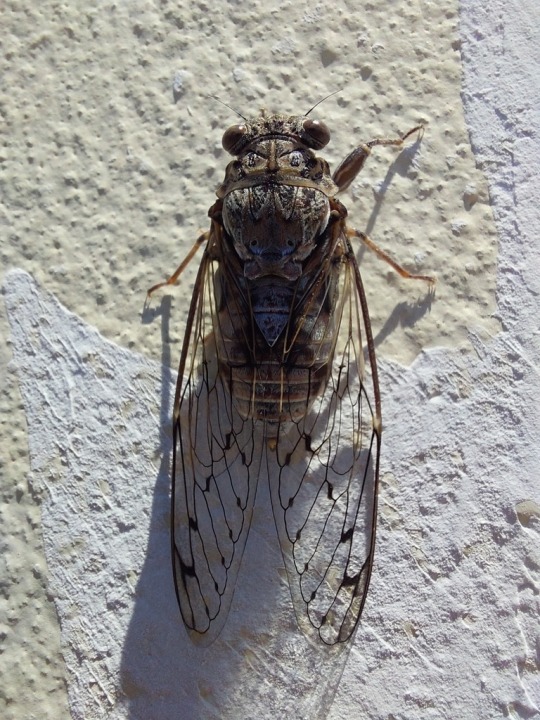

[images: left - the east aegean cicada; right - the ash cicada]
then, I decided to read a truly excessive number of scientific research papers about cicadas in the mediterranean. why did I do this? besides reasons of entomology-associated passion (and legitimate professional interest), I did it because I learned that it turns out that basically, the aegean sea constitutes a ���hot spot of cicada diversity,” with numerous species across different genera that nevertheless look—pretty much all the same! quite quickly, it became apparent that one blurry instagram image would be insufficient to determine the species. in fact, even if the image had been crystal clear, it wouldn’t have mattered. apparently, many cicadas of the eastern mediterranean are not morphologically distinct (meaning, again: some of them look identical) and what differentiates them is actually, primarily, their songs. they are “acoustically divergent,” with females being able to locate males of their own kind by their unique calls alone, not their looks. different species also tend to be distributed differently across this region, by which I mean some are only found on certain islands, or in certain areas of Italy, the Balkans, Greece, or Turkey, or Greece and Turkey, etc etc. I needed to read to form a better picture of all of this, essentially, and to gather clues.

[image: some of the papers I read]
after perusing all of this fascinating literature—and also squinting really hard at dnp’s picture and the photos of cicadas we had accumulated—I came to the conclusion that, most likely, the cicada was either Cicada orni, the ash cicada, or potentially more likely, Cicada mordoganensis, the east aegean cicada. both had three observations recorded in the region of interest (the most observations of any species), and both had the most similar coloration and patterning to dnp’s cicada. my predilection for the east aegean choice stemmed from two things: 1. the east aegean cicada observations were of a higher quality (research grade) than the ash cicada, and 2. the papers I had read were telling me that while east aegeans were prevalent along the entirety of the our region of interest, ash cicadas were more constrained, geographically, to northern Turkey and the Greek mainland. in fact, according to mediterranean cicada scientists, no ash cicadas had ever been found on islands as southeast as Samos and Ikaria, two islands relatively close to the peninsula where dnp’s cicada resides. this contradicted the observations on iNaturalist.
apparently, this difference in distribution has a lot to do with the tectonic and geographical history of the eastern mediterranean. where certain cicadas are today has a lot to do with where warm refuges from ancient glaciers existed thousands and millions of years ago (cicadas like the heat). also, and I should not necessarily subject you to this tangent, but did you know that about 5 million years ago the mediterranean sea simply gave up on existence for a little while? ... during the Messinian Salinity Crisis, the mediterranean simply stopped being a sea for a little while and almost dried up completely, allowing certain creatures that could not otherwise traverse an entire sea to disperse across it, except for where there is a huge ass canyon in the seafloor, and—




[images: highlighted, pertinent sections of papers discussing cicada distribution; relief map of the mediterranean seafloor]
anyway, what we were sorely missing at this stage were sound recordings of the cicadas. despite the evidence against the ash cicada, this cicada is still one of the most commonly found cicadas around the aegean sea. also, some of the studies I found were ten or more years old—who knows how climate change or other factors may have impacted the location of cicada populations since they were published.
while the audio of the cicadas outside in Phil’s video is poor, Dan does an imitation at 00:30 of what they’d been hearing during their trip. knowing Dan, this imitation is not merely a made-up, vaguely cicada-like noise, but an actually good approximation of the song that had been driving them crazy (this whole study mayhaps hinges on this lmao). if only we could uncover audio of these cicadas, maybe we could know for sure if this insect was of the ash or east aegean variety.
thankfully, at this point I was still reading papers. even more thankfully, the ten individuals who seemed to have cornered the market on mediterranean cicada studies since the 1970s made a website, and mentioned it in one of their papers. it is an exceptional, beautifully designed website called cicadasong.eu that evokes the ad-free, uncluttered, cozy and homemade feeling of the early noughties internet. it almost made me cry, and @/pierogish reported that seeing this website made her realize that in all these years recently spent online she had been choking, and only on cicadasong.eu was she finally able to breathe freely. on this website, there happen to be embedded YouTube videos of high quality audio recordings of all the european cicadas its creators have ever studied.
at last! comparisons of cicada songs to Dan commenced, and we were able to play the ash cicada’s sound alongside the east aegean’s and Dan’s. at the top of this post, you will find the compilation of these three sounds. here are the links to the original audio videos of the east aegean and ash cicada.
the main unit of sound—the chirp—of a cicada’s song is known scientifically as an “echeme”. in these audio files, you can perceive that, for the east aegean cicada, the duration of the echeme is longer, meaning the number of echemes per second is lower. this rhythm, and in general the structure of the east aegean cicada’s song was, in comparison to the ash cicada’s, deemed to the ear of all the authors and contributors definitively more similar to dan’s cicada song. thus, this final piece of evidence seemed to complement the rest of our data and confirm our initial assumption of the cicada’s identity.
conclusion
accumulated data has lent support to our hypothesis that the cicadas suffusing the atmosphere of dip and pip’s holiday resort with their ebullient, lascivious songs were east aegean cicadas.
#dnp#my regularly scheduled science/animal-themed contribution to the community#dan and phil#cicadas#entomology#insects#bugs
247 notes
·
View notes
Text

"Mycenaean women put their own spindles to splendid use, producing luscious cloaks and long, richly patterned or striped skirts. Far from resigning themselves to the weaving rooms, they travelled in chariots, performed songs or poetry to the accompaniment of lyres, and carried wheatsheaves for public ceremonies and rituals, as vibrantly coloured frescoes from the palace at Mycenae reveal. In one of the most enigmatic paintings, one woman holds a sword, another a spear, while two tiny men, one painted red and the other black, float mysteriously between them, like toy models or thought bubbles. Through their contact with the divine, perhaps, the women pictured gain agency over the men’s fate. Hera, Zeus, Poseidon and a female birth and death goddess known as Potnia were among the deities the Mycenaeans are known to have worshipped. While Mycenaean women clearly played an important role in religion, their political position within the palaces was weaker than that of their Minoan counterparts, and secondary to the men’s. Each Mycenaean palace complex was presided over by a male ‘wa-na-ka’ or wanax.
Surviving clay writing tablets provide just as fascinating an insight into the lives of women in the real palaces of the Mycenaean era. The fullest collection of tablets comes from a pair of rooms in the palace complex of Pylos, but Knossos, the former Minoan capital, was also a key repository. A total of 4,476 tablets have been preserved across the two sites. Among these there are references to more than 2,000 different women. Unlike Linear A, the Minoans’ writing system, the Mycenaeans’ similarly syllabic Linear B has been successfully deciphered. Working (as opposed to non-working elite) women were denoted by signs resembling an abstract impression of the female form. ‘Woman’ was conveyed by two dots for breasts, legs joined to suggest a long skirt of the kind Mycenaean women wore, and a curved line where her head would be, suggestive of long or dressed hair (in the sign for a man, by contrast, there is a straight line for the head).
The women referred to in the tablets were employed in a wide range of jobs, many of them familiar from the Homeric epics. In the Odyssey, women grind wheat and barley, ‘the marrow of men’, at mills. There were ‘flour-grinders’ at the palace in Pylos. In both epics, women weave, whether royal or servile. Andromache works in the Trojan palace with a loom and distaff while ordering her servant women about their work. Helen embroiders a purple cloth with scenes from the Trojan War as if she were telling the story of the poem herself. And as we have seen, Penelope weaves and unweaves a funeral shroud for her father-in-law, Laertes. The women who wove at Pylos and Knossos were no less versatile in their handiwork. They managed something like a textile industry, producing goods for export as well as the palace community, and worked in groups according to specialism. There were wool-spinners and carders, linen- and leather-workers, finishers and headband-makers for horses. These women usually worked separately from men, but at Pylos there is evidence that at least two women, Wordieia and Amphehia, formed part of a mixed leather-making group.
Working groups were the modus operandi at the Mycenaean palaces. Women were usually accompanied by boys and girls, presumably their own children, as they went about their tasks. Many were divided also according to their geographical region. Pylos was split into sixteen districts over two provinces, Nearer and Further, separated by Mount Aigaleo. The palace-workers came from more than 200 named places, some of which may have been local streets, while others, including Lemnos, Miletus and Knidos, lay further afield. It is possible that, like the Sidonian (Phoenician) women carried to Troy by Paris in the Iliad to weave fine robes for the court, some of the women working in the Mycenaean palaces had been enslaved.
Although the women were engaged in hard, practical labour, their work was recognised as highly skilled, and the Mycenaeans took some pride in it. Men were sometimes described on tablets as being the offspring of women of particular crafts, for example, ‘sons of flax-workers’. Female workers were allocated the same amount of food in the regular distributions as their male counterparts, and twice as much as their children, whereas in Babylonia, men typically received three times the female ration.
A mysterious senior class of priestess at Pylos known as ‘keybearers’ (did they open and close shrines within the palace complex?) even owned land. A landowning keybearer named ka-pa-ti-ja (‘Karpathia’) was wealthy enough to donate almost 200 litres of grain to the palace, probably for a religious festival. Given the historical prominence of women at the court of Pylos, it is fitting that a mythical Pylian king should intervene in the dispute over Briseis in the Iliad. Old Nestor urges Agamemnon to return the woman to Achilles and to end their feud."
The Missing Thread: A Women's History of the Ancient World, Daisy Dunn
#history#women in history#women's history#historyedit#mycenaean greece#ancient greece#bronze age#ancient world#working women#women's work#greece#greek history
175 notes
·
View notes
Text


Hello! After having some time to get over my loss for the Pokemon TCG Illustration contest, I decided to write up a small blog entry about the process and include some WIP pictures. Feel free to look below if you want to read my ramblings on the process.
Idea Generarion-
So coming into this contest, I knew I wanted to make a mixed media piece. In terms of theming I chose something that not only reflected a “magical moment” for a Pokemon (in this case meeting a legendary Pokemon), but also a moment when playing the games myself. In fact this piece was inspired by my awe when I first encountered a box legendary in game, as before I thought my teacher was lying to me when he said you can catch the legendary on the box!
This is the concept sketch that started it all! At the time my main concern was getting ideas down and seeing how they looked. Thinking about things like how would the composition would look, how would the colours look. So on and so forth.
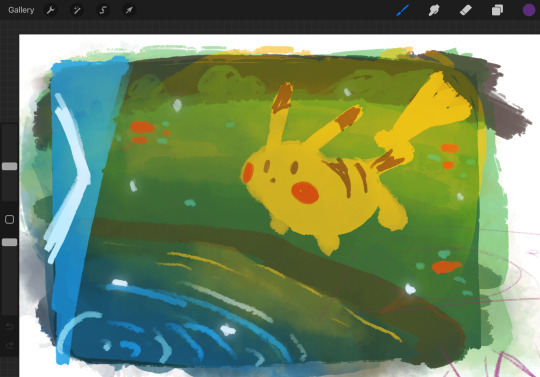
I didn’t want to focus too much on the sketch and wanted to start making the physical object, so out of some cheap paper I started making a set up testing out size, scale, composition. I didn’t want to get too attached to the original sketches only to realise I couldn’t make it in real life… I went though a few drafts trying to get things right, slowly adding in aspects such as background objects and higher quality drawings.
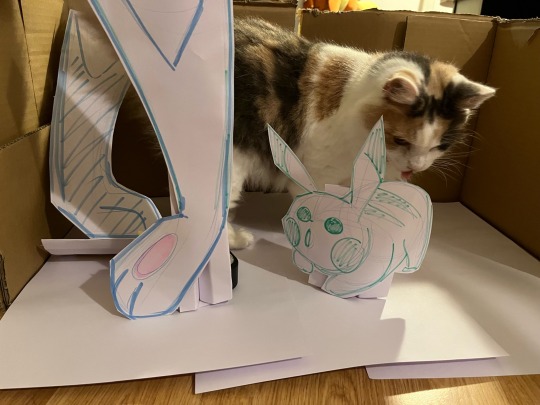

After completing the draft I bought the images back into procreate to experiment with colours. This is the point where I made the mistake of thinking I had plenty of colours to choose from, not realising I would be limited by what I could buy from various yarn shops. That or hope I could find the right colour online, but that was always a gamble. If I don’t stop talking about this now I’ll get sidetracked talking about how much I miss yarn shops…

Anyways, I cut out the individual pieces that I would make within the background and used them as a guide for crochet assets. For this part I wanted to use different stitches to create textures such as the ripple stitch, bobble stich and some cable stitches, I feel bad as I never took any work in progress photo so of them. Let’s pretend you’re looking at a photo of a half finished crochet abstract shape.
Finally onto the main event, the Pikachu (and Suicune). The decision to make Pikachu a plush was based on what I would have liked to make for the 2022 illustration contest (if I wasn’t geographically challenged!!) Despite being British I decided it would be fun to make anyways, so I could experiment. I never got around to that but decided it would be fun to try for this edition.
Making the pattern was HARD! As I wanted Pikachu to have a unique pose, I had to work out different methods to plush i’ve made in the past which have been somewhat relaxed in their posing. I ultimately ended up making each part individually, pinning it together and then making adjustments as needed. It didn’t start out great however I ended up with this weird Pikachu shaped thing that did the job. Throughout this process I would regularly photograph it in the background to try and catch any issues early on. For example if the ground needed to be a different shape.


Photographing the final price was interesting. I felt bad for my partner as I essentially turned my dining table into a mini photography studio! I spent several days waiting for different lighting opportunities and experimenting with different light. Marking down different camera angles to ensure I have all of my bases covered. I easily took over 100 photos to get the perfect shot! In the below photo you can see washi tape being used to rest out different positions for the sculptures.

And that leads me to the peice! Even though i’m sad I didn’t make the top 300, I am pleased with the work I did for this piece (and my flygon entry too!). I’m glad I decided to experiment with ts peice and look forward to refining my methods in the near future!
#pikachu#ptcgic2024#ptcg contest#Plush#Pokemon#pokemon plushie#pokemon plush#pokemon illustration#crochet#electric type#Gen 1#creative#pokemon art#katart#katblog#katplush
228 notes
·
View notes
Text
Two Banishing Powders from a Southern Folk Witch

In Southern folk magic, the formula used for a banishing spell varies a little bit based on whether you want to banish an actual person (basically getting them to leave you alone) or a spirit/energy/abstract concept.
Banishing formulas for getting rid of living people tend to focus on causing irritation and discomfort to get someone to leave, which may be less effective if they don't have a physical body. Banishing formulas for spirits/energy are more about deep cleansing and making the space inhospitable for undesirable spirits. The herbs and minerals a practitioner might reach for are different in these two situations.
Below are two all-purpose banishing formulas from my practice: one for living people, and one for spirits.
GTFO Powder
For getting rid of unwanted (living) people.
You will need:
The spiciest red pepper flakes/powder you can find (If you like spicy food, use something so hot you can't eat it in large amounts. I like spice and I use Szechuan pepper flakes, but cayenne will work, especially if you know the person you want to banish doesn't like any spice at all in their food. Discomfort is the goal here.)
Black pepper (Used here to cause mild inconvenience/discomfort/bad luck)
Salt (Good, old fashioned banishing)
(Optional) dried, crumbled wasps nest*
(Optional) dirt from the side of a busy road or highway**
*This is actually much easier to find than you'd think, but be careful not to get stung! This is a traditional ingredient in Southern folk magic because wasps are known for how viciously they protect their homes. Fair warning: this is a mean ingredient (since its purpose is to cause pain/discomfort), so I'll leave it up to you whether to include it or not. If you're dealing with a stalking or abuse situation, wasps nest can give you the extra oomph you need to help keep the abuser from returning.
**Only include this if you're trying to make someone physically leave your space or relocate to a different geographical area. And PLEASE be careful collecting this dirt! My advice is to try to collect it during a less busy time of day and to stay several feet away from the actual road.
How to Use It:
When you mix up this powder, speak over it and state your intention. You can enchant this powder for all-purpose banishing, or you could mix up a batch to banish a specific person. Either way, it is important that you tell the powder what it is meant to do. I like to speak directly to the spirits in the powder and ask them for their help.
Traditionally, you would use this powder by sprinkling some in your target's shoes, but that isn't always possible. You can use it in poppet spells by adding it to the feet of the poppet for the same effect. You can also use it to dress candles, add it to jar spells, or incorporate it into other types of banishing spells. Warning: do not burn this powder, as it can cause irritation or injuries to the lungs.
If you need to get rid of a specific person, you'll want to customize the powder to only work on them. The easiest way to do this is with a taglock (an item that has a physical connection to the target). Some of their hair would be ideal, but you can also use a photo of them or even a piece of paper with their name and address written on it, like you were addressing a letter. You'll want to burn the taglock to ash, then mix this ash into the powder. Make sure you burn it outside, because the smoke will be unpleasant.
You can use this powder to keep someone away from your home or another building by sprinkling a line of it across all entrances to the building. If you do this, make sure you've customized the powder for that person with the method above -- otherwise you may accidentally banish ALL visitors.
Ghost-Be-Gone Powder
For getting rid of unwanted spirits or psychic energy. Can also be used to banish non-physical things, like an illness or a bad habit.
You will need:
Asafoetida*
Salt (Again, used here for good, old fashioned banishing)
Garlic (You know how garlic is supposed to repel vampires? That's basically what it's doing here.)
Rosemary (Used for cleansing and banishing)
(Optional) dirt from a church, temple, or other place of worship**
*Honestly, I've used asafoetida by itself for banishing and gotten really good results. This is definitely the Big Daddy of cleansing herbs in Southern folk magic. You can usually find this in international grocery stores or get it online for fairly cheap, and it's one of the few herbs I think are worth going out of your way to get. Warning: a lot of people complain about the smell of asafoetida, but it honestly just smells like a stronger, more pungent garlic to me so your mileage may vary.
**While dirt from a church is traditional, use something tied to a religion YOU believe in. If you aren't Christian, don't use church dirt. For myself, I might use dirt from the Wiccan temple near my home or from another pagan holy site. The point here is to call on your personal spiritual allies for help. If you are an atheist or agnostic, just leave the dirt out entirely.
How to Use It:
When you mix up this powder, speak over it and state your intention. You can enchant this powder for all-purpose banishing, or you could mix up a batch to banish a specific spirit. Either way, it is important that you tell the powder what it is meant to do. I like to speak directly to the spirits in the powder and ask them for their help.
To use this powder to remove a spirit from your home, use it to clean your floors. You can sprinkle it on the floor, let it sit for a few minutes, and then sweep or vacuum it up.
I don't recommend burning this powder as incense, but you can use it in spells. You can place a ring of it around the base of a black candle or add some to a jar spell, for example. You can also use this to cast a circle around your spellwork if you want to protect it from interference in the spiritual realm.
A Note on Cultural Appropriation
Every time I post some of the more folksy parts of my practice online, I get asked whether it's okay for others to use these spells. Specifically, people want to know if these spells come from a closed tradition or if they have to live in the South to use them.
The folk magic tradition I practice is not tied to any closed cultural practice. I will never post anything from a closed practice online. So yes, you can use these powders no matter who you are or where you are from. You don't have to live in the South or be from the South to practice Southern folk magic, but you will get more out of your practice if you have a connection to the region.
On a related note: some of y'all may have noticed that these powders are similar to formulas used in Hoodoo. The GTFO Powder specifically is very similar to Hotfoot Powder, which is used for a similar purpose in Hoodoo. Hoodoo is a semi-closed African-American tradition that is typically passed down in families or communities. When I post about my practice, I do occasionally get comments accusing me of appropriating from Hoodoo.
Here's the thing: my practice does have some overlap with Hoodoo, because I am in the same geographical region and part of the same regional culture that Hoodoo comes from. Over hundreds of years, ideas get exchanged across racial and cultural lines. Just like some elements of Hoodoo come from European traditions, some elements of white folk magic in the South come from African roots. It's not appropriation -- it's a natural result of living in multicultural communities.
All of this is just to say, what I do is not Hoodoo, but I think of my tradition and Hoodoo as cousins. There's some shared DNA, but also a lot of differences. How I do things might look similar to how a Hoodoo practitioner does them, but the theory or exact ritual process may be different.
#southern folk witchcraft#southern folk magic#folk witchcraft#appalachian folk magic#southern appalachia#folk magic#banishing#banishing powder#banishing spell#witchcraft#witch#green witch#green witchery#kitchen witch#kitchen witchery#long post#mine
454 notes
·
View notes
Text
Harmony in Hustle: Navigating the Balance Between Work and Nature 🌿💼🌐
The Urban Jungle and the Green Oasis: A Symbiotic Dance
Contemplate the symbiotic dance between the urban jungle of work responsibilities and the green oasis of nature's tranquility. As professionals navigate the bustling cityscape, the call of nature stands ready to provide solace, inspiration, and a much-needed breath of fresh air.
Nature Breaks: Recharging Amidst the Leaves and Breezes
Discover the power of nature breaks in recharging the mind and body. Whether it's a stroll in a nearby park during lunch or a weekend hike to escape the confines of screens, these breaks offer moments of serenity and reflection, enhancing focus and creativity upon return to work.
Digital Detox: Unplugging for Mental Wilderness
Reflect on the importance of a digital detox as a means to wander into the mental wilderness. By unplugging from screens and immersing oneself in the sights and sounds of nature, individuals can cultivate mental clarity, reduce stress, and foster a deeper connection with the world around them.
Outdoor Workspaces: Where Productivity Meets Fresh Air
Explore the concept of outdoor workspaces where productivity meets fresh air. The integration of work tasks with the natural backdrop of parks, gardens, or outdoor cafes creates an environment that harmonizes professional duties with the invigorating energy of nature.
Seasonal Reflections: Aligning with Nature's Rhythms
Align with the rhythmic cycles of nature to foster a sense of balance. Embrace the changing seasons as an opportunity for reflection, adaptation, and intentional shifts in work-life integration. From the vibrant blooms of spring to the serene blankets of snow in winter, each season offers unique perspectives on balance.
Work-Life Blend: Redefining Boundaries for Well-Being
Contemplate the concept of work-life blend as an alternative to the traditional work-life balance. By integrating work and personal life in a more fluid manner, individuals can create a harmonious existence that acknowledges the importance of both professional aspirations and the nurturing embrace of nature.
#outline#doodle#terrain#contour#minimalist#green#topographic#mapping#simple line#topographical#geological#abstract#landscape#geographic
0 notes
Text
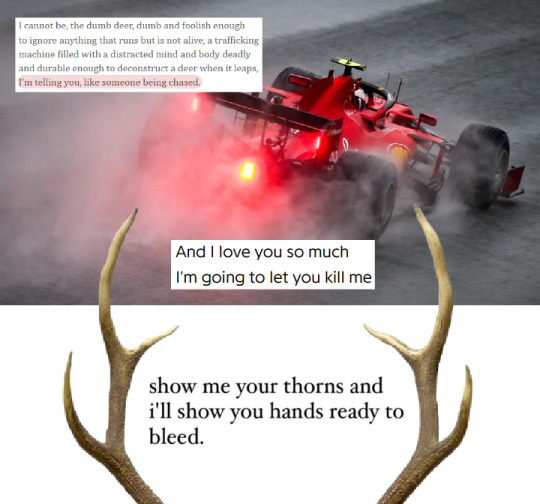
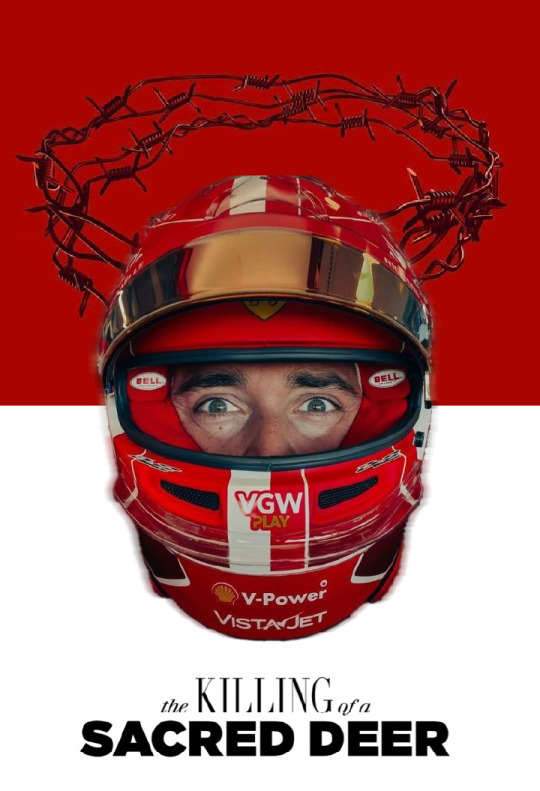
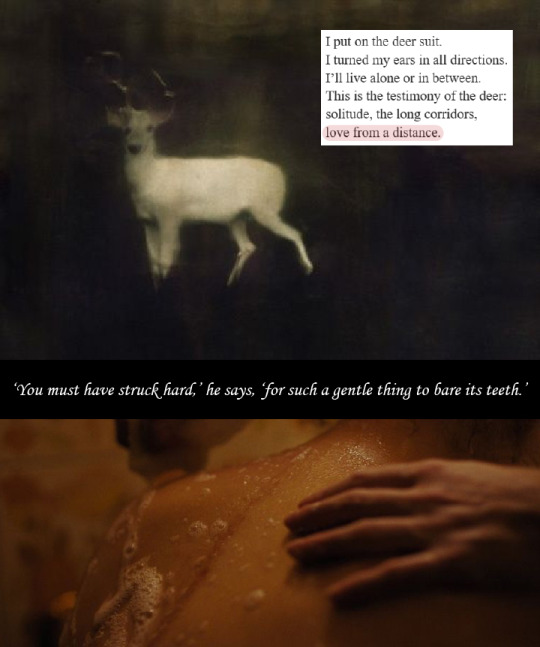
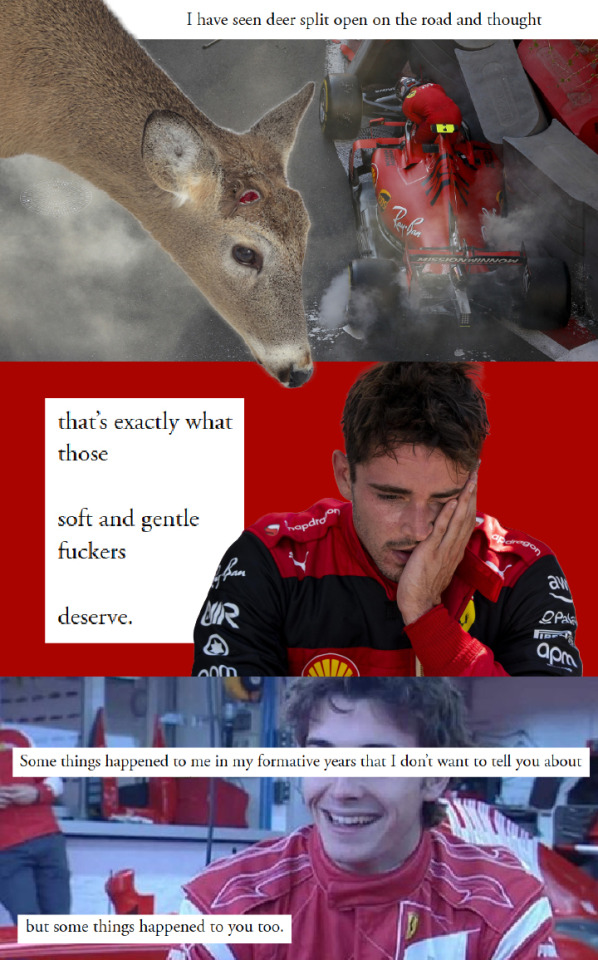



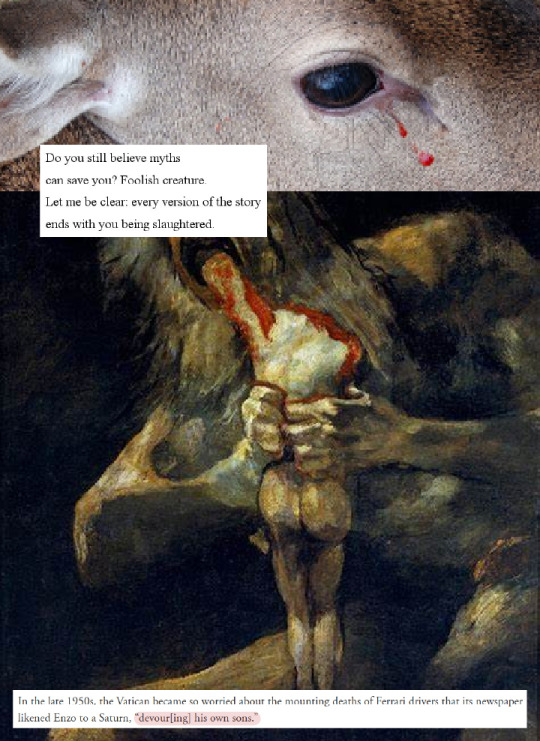
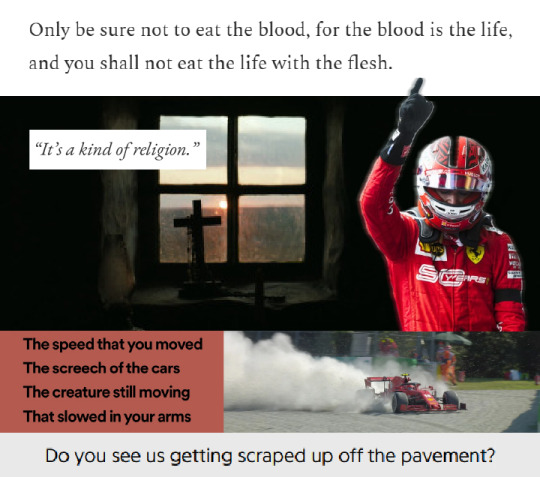
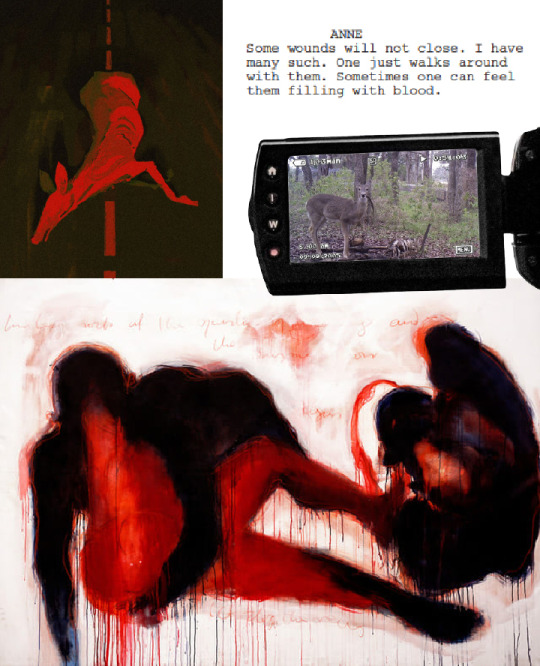
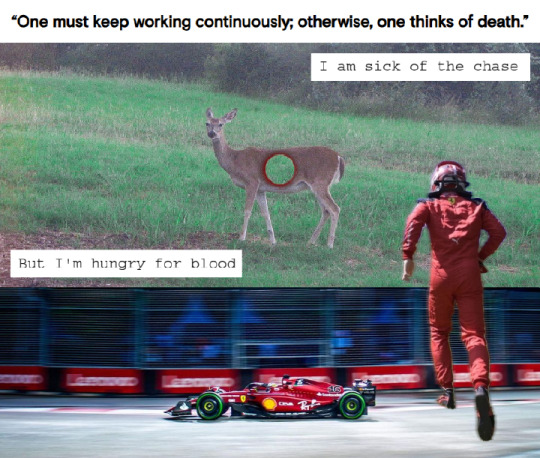

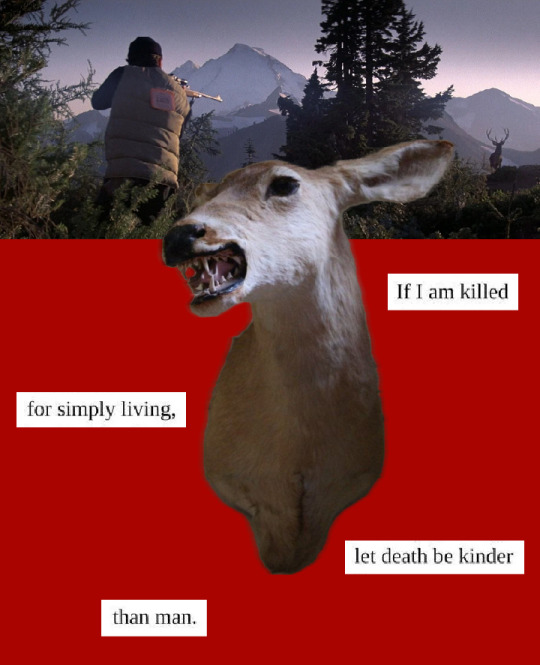
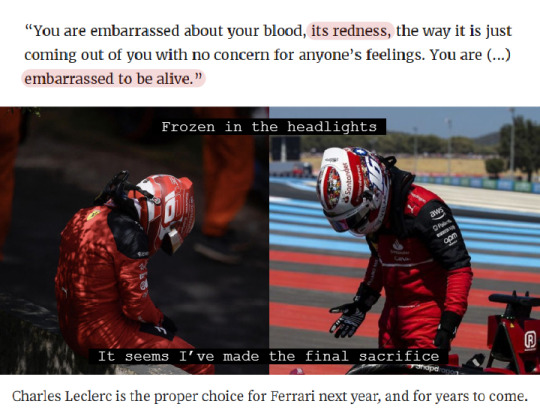
DEER THEORY
WORDS: ‘The Deer’ by Terrance Hayes / ‘I’m Not Calling You a Liar’ (Florence + the Machine) / Aaron O’Hanlon / The Killing of a Sacred Deer (2017) dir. Yorgos Lanthimos / ‘The Stag and the Quiver’ by Richard Siken / mine / ‘Salvage’ by Hedgie Choi / ‘A Letter to My Mother That She Will Never Read’ by Ocean Vuong / ‘Little Deer’ (SPELLLING) / ‘Grendel’ by Roger Reeves / ‘Herd of ‘panicked’ deer filmed jumping to their deaths from motorway’ by Tanveer Mann (Metro UK) / ‘Kinder Than Man’ by Althea Davis / ‘Anecdote of the Pig’ by T. Adkisson / ‘Ferrari Drivers Charles Leclerc and Carlos Sainz Are Racing Back to the Top of F1’ by Tom Lamont (GQ Sports) / Deuteronomy 12:23 / ‘‘It’s a kind of religion’ - Ferrari’s popularity and following in Italy dissected’ by Akshat Kabra (Sportskeeda) / ‘Abstract (Psychopomp)’ (Hozier) / ‘Not Strong Enough’ (boygenius) / The Favourite (2018) dir. Yorgos Lanthimos / Enzo Ferrari / ‘Killer’ (Phoebe Bridgers) / CL for ‘Charles Leclerc talks about his “Red Passion”’ by Roberto Croci (L’Officiel Ibiza) / ‘The fragility of a predestined | FormulaPassion.it’ by admin_l6ma5gus (Pledge Times) / ‘Kinder Than Man’ by Althea Davis / Carmen Maria Machado, In the Dream House / ‘Rabbit Heart (Raise It Up)’ (Florence + the Machine) / ‘Ferrari Needs to Sign Charles Leclerc for the 2018 Formula One Season’ by Gabriel Loewenberg (The Drive) IMAGERY: Styrian GP (2020) / ? (antlers) / ? (crown of thorns) / Scuderia Ferrari Press Office (2023) / @velvetbambi (x) / Saint Maud (2019) dir. Rose Glass / white-tailed buck shedding its antlers (via Deer & Deer Hunting) / Azerbaijan GP (Baku, 2019) / post-French GP (2022) / Jules Bianchi (via F1 TV) / George Shiras III for National Geographic (1906) / ? (young CL) / ‘Driver-Deer Collisions On The Rise: State Farm’ (WSLM RADIO) / Male Red Deer (antlers) / post-Bahrain GP (2019) (CL looking up from hands) / ‘roadkill’ by Loso (via Flickr) (x) / Saturn Devouring His Son (1819-23) Francisco Goya / post-Belgian GP (Spa, 2019) (CL pointing upwards) / The Banshees of Inisherin (2022) dir. Martin McDonagh / Italian GP (Monza, 2020) / Nathan Sandwell @cuchulainn-4 (x) / ? (camcorder) / ‘Deer Caught Gnawing on Human Bones’ by Jason Daley (Smithsonian Magazine) / A Fragment of Ourselves Returning (2018) Beatrice Wanjiku / @nightcorp-archive (x) / Brazilian GP (2023) (CL figure walking) / Singapore GP (2022) / post-Qatar GP (2021) / The Deer Hunter (1978) dir. Michael Cimino / ? (dogmouth doe) / Brazilian GP (2023) / French GP (2022)
271 notes
·
View notes